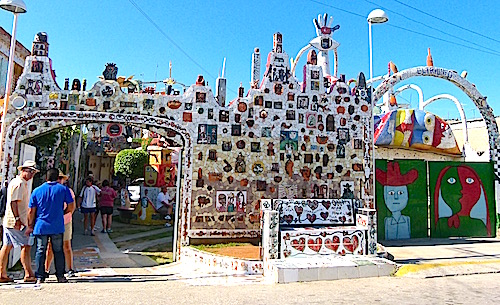Shore excursion: Cuba’s Fusterlandia is one man’s attempt to brighten the world
Outrageous colors. Fantasy figures. Proud historic reminders. Everywhere I looked, it seemed an eye-catching explosion of creativity.
I had been forewarned but I’m not sure anything can prepare you for Fusterlandia. The artistic wonderland is certainly not something I expected to encounter when I arrived in Havana.
“Some people thought he was crazy,” tour guide Isora said. “People were going hungry when he started doing this. And here he is building houses.”
But Cuban artist José Fuster knew what he was doing. He brought joy to people during difficult times and revitalized a derelict neighborhood at his own expense, in his own time and with his own unusual talents.
The result can’t help but bring smiles and amazed exclamations at all the art work decorating his home and surrounding houses.
“He started in 1992 and now look at it,” Isora said. “People come from all over the world to see this. They say they’ve never seen anything like this before.”
I agree.
Born in 1946 in a small fishing village outside Havana, Fuster is a man of many talents. He sketches, paints, engraves and is an internationally-celebrated ceramist. He also is an outspoken supporter of Fidel Castro and the Revolution and says he is a product of the communist-ruled system which offers free education and free healthcare.
At 14, Fuster went to Castro’s guerrilla army stronghold in the Sierra Meaestra mountains to teach peasants how to read in the country’s Literacy Campaign. He studied at the state-run Art Instructors School from 1963 to 1965 and began working as a ceramist at the Cubanacan Ceramics Workshop in Havana in 1966.
When he moved to his home and studio in the seaside village of Jaimanitas on the northwestern edge of Havana, Fuster started brightening his space with his art work. Before long, he began doing the same for his neighbors. He also helped fund some of their house repairs with his art sales.
In a country where most people are very poor and barely getting by, it is difficult to afford home repairs or decorations. Stretching the food they get from their ration books and figuring out how to get more food is a main concern for many Cubans. So how did art help?
“It made people happy,” Isora. “And proud.”
Fuster has artfully decorated about 50 houses in the neighborhood, Isora said. “This place was very different 25 years ago. José Fuster pays for everything and he works for free. He plans to finish the whole neighborhood.”
No admission is charged to enjoy Fusterlandia. If the artist is in his second-story home or studio, he often will come out and visit. I didn’t get to see him but that doesn’t mean he wasn’t there.
Inspired by nature, Santeria, Picasso and Spanish architect Gaudi, Fuster’s ever-evolving masterpiece requires close looks to catch all the details. It seems as though no space in his kingdom has been ignored.
Even the staircase is decorated with art which can be distracting because I would rather look at the beautiful steps than where I am going. Fuster’s fantasyland is chock full of paintings and playful ceramic figures like mermaids, palm trees, fish, horses, stars, hearts, roosters and crocodiles. A tilted chimney clock is stuck permanently at 3 o’clock.
Political undertones are there as well. Look for the Cuban flags, a huge mural of Fidel Castro’s face and a mural of the Granma boat which transported Fidel Castro, Che Guevara and other Cuban Revolution fighters from Mexico to Cuba in November 1956 to overthrow the American-backed Batista regime.
Even chimney pots have not escaped Fuster’s creativity. Emblazoned across the sky on eight chimney pots are the words “Viva Cuba.”















View Recent Comments